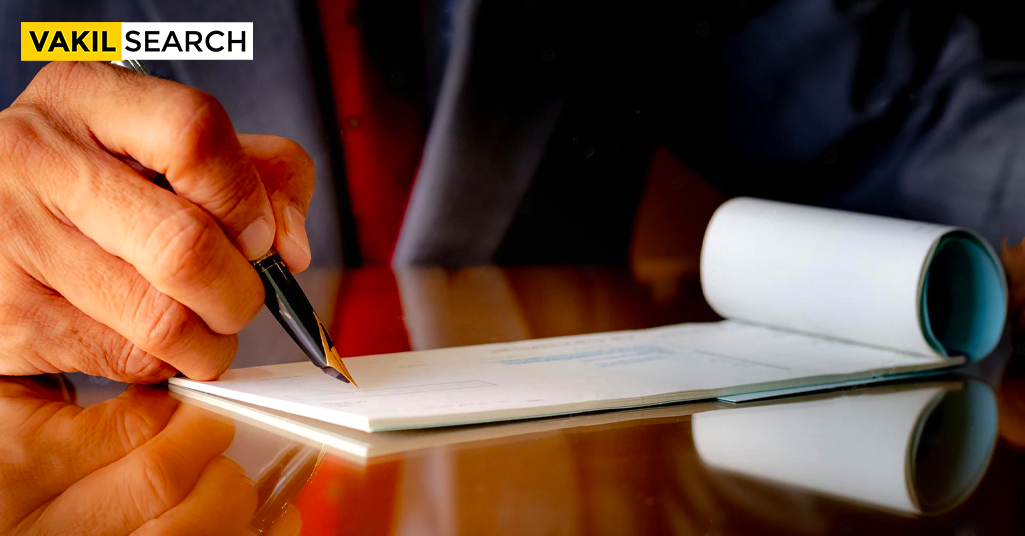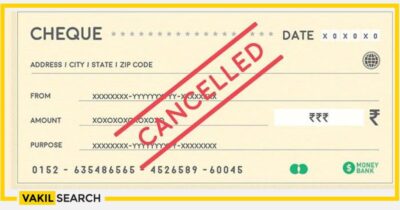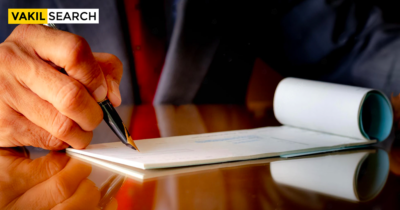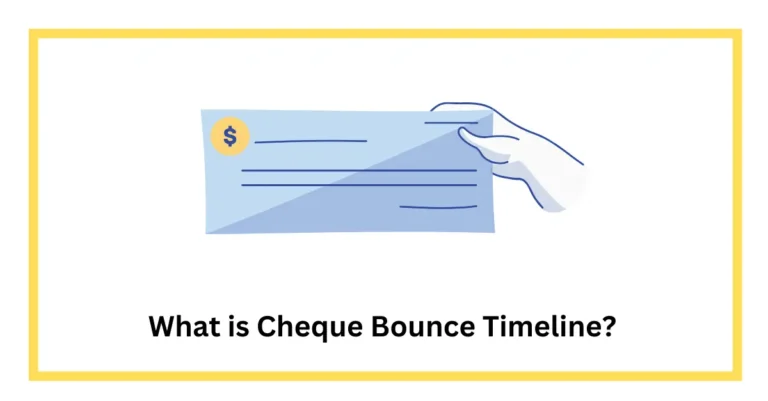Discover how India grapples with this issue, from overwhelming pending cases to Supreme Court recommendations and the need for amendments.
A cheque, meticulously detailed, serves as a written contract. It incorporates essential elements—details of the payee, issuance date, specified amount, and the drawer’s signature. When a bank issues a cheque, it is equipped with the drawer’s name and account particulars. This comprehensive document encapsulates the transaction’s essence and legitimacy, making it an indispensable financial instrument. Entering the realm of financial disputes, the Legal Notice of Cheque Bounce holds pivotal significance. In this blog, we explore the intricacies of issuing a legal notice in the event of a bounced cheque, shedding light on the crucial steps and implications for both parties involved.
Why Do Cheque Bounces Happen?
Issuing a cheque might seem simple, but it’s like setting off a chain of possible problems that can make the cheque ‘bounce’ or not work. There are many different reasons why a cheque might bounce, ranging from small mistakes to big issues. Even something as simple as misspelling a name, getting the date wrong, or writing the wrong amount can cause big money troubles. This is why it’s super important to be really careful when you’re dealing with cheques.
Think of a cheque like a dance involving numbers and signatures. It’s a fragile process that can easily be messed up. If we look at the situations where cheques bounce, we can see some common reasons why this happens and how it can lead to legal problems:
Not Enough Money: If you try to pay more money than you have in your bank account, the cheque will bounce. It’s like a bridge breaking because there’s too much weight on it.
Signature Doesn’t Match: Your signature on the cheque has to match what the bank has on record. If they don’t match, the cheque won’t work.
Cheque is Old: Cheques have an expiration date. If you use a cheque after this date, it won’t work anymore.
Cheque Deposited Too Early: Sometimes people deposit cheques before they’re supposed to, and this can cause them to bounce.
Different Amounts: If the amount you wrote in words doesn’t match the numbers, the cheque might bounce.
Damaged Cheque: If the cheque is wrinkled or torn, the bank might not accept it.
Messy Changes: If you scribble or change things on the cheque, it might not be accepted. Overwriting without making it clear can also cause problems.
Using a Closed Account: If you try to use a cheque after closing your bank account, it won’t work.
Life Changes: If the person who wrote the cheque passes away, becomes broke, or has mental issues, the cheque might not be accepted.
Crossing the Rules: Sometimes adding extra lines on the cheque can cause it to bounce.
Too Much Money: If you try to take out more money than your overdraft limit, the cheque won’t go through.
Wrong Bank or Doubts: If you deposit the cheque in the wrong place or the bank thinks something is fishy, the cheque might bounce.
These are important things to remember when you’re using cheques. If something goes wrong, it can lead to legal problems and you might get a notice from the law because of the bounced cheque.
Validity of a Legal Notice of Cheque Bounce
When a cheque bounces due to non-payment, it sets in motion a sequence of legal actions that can have far-reaching implications. At the core of this process lies the validity of the Legal Notice of Cheque Bounce—a crucial step that paves the way for potential legal proceedings. Let’s delve into the key aspects that define the validity of such a notice and its pivotal role in navigating the intricate landscape of financial disputes.
A Legal Notice of Cheque Bounce, issued by a lawyer on behalf of a client, serves as a formal indication of impending legal action. It arises from the non-payment of a cheque and stands as a final warning before legal proceedings commence. However, for such a notice to be considered valid, it must adhere to specific conditions and adopt the correct format.
The underpinning of a valid notice lies in its alignment with Section 138 of the Negotiable Instruments Act, 1881. This statute acts as a guiding framework, ensuring that the notice comprehensively addresses the situation. Among the vital elements that the notice must encompass are:
Drawer Details: The notice should clearly specify the details of the person who issued the cheque, also known as the drawer.
Drawee Information: It’s imperative to include the name of the beneficiary or the entity to whom the cheque was issued.
Legal Context: The notice must explicitly state that it is being issued in accordance with Section 138 of the Negotiable Instruments Act, 1881.
Debt Clarification: To ensure the notice pertains to a valid case, it must indicate that the cheque was issued to fulfil a pending debt or liability. Cheques presented as gifts or donations are not subject to legal scrutiny.
Cheque Presentation: The notice should confirm that the cheque was submitted to the bank within the valid time frame.
Return Details: It’s essential to mention the date on which the bank returned the cheque, along with the reasons for its rejection.
Time Frame: The notice must reach the drawer within 30 days from the date of the cheque’s bounce. It should also grant a 15-day window for the payment of the cheque amount before initiating legal action.
Mode of Delivery: To ensure authenticity and proof of delivery, the notice should be sent via registered post.
The intricacies of composing a valid notice reflect the seriousness of the matter at hand. While the drawee can send this notice, seeking guidance from a legal practitioner is highly advisable to ensure compliance with legal norms.
Procedure to Be Followed When You Receive Legal Notice of Cheque Bounce
Receiving a Legal Notice of Cheque Bounce can be unnerving, but understanding the proper procedure to follow can help you navigate through this legal challenge. If you find yourself on the receiving end of such a notice, here’s a step-by-step guide on how to proceed:
Acknowledge the Notice: When a cheque you issued is repeatedly rejected by the bank, and you receive a legal notice for the cheque bounce, take it seriously. This notice is a formal request for payment of the cheque amount.
Seek Legal Counsel: Before taking any action, consult with a legal practitioner who specialises in cheque bounce cases. Their expertise can provide you with the necessary guidance to address the situation correctly.
Assess Your Options: You have two primary options: respond to the notice or pay the cheque amount. This decision hinges on your legal counsel’s advice and your individual circumstances.
Respond to the Notice: If you choose to respond, your reply should be directed to the drawee’s lawyer. Include important details like your name, address, and a comprehensive account of the issue. Highlight the date of the cheque issuance, the reasons for its return, and any pertinent facts. It’s crucial to address each allegation made against you, while refraining from admitting to any wrongdoing without proper legal advice.
Present Your Defense: Your response is your chance to present your side of the story. Articulate your rebuttal to the allegations and provide any relevant evidence to support your case.
Consult Legal Counsel: Your legal practitioner can help craft an effective reply, ensuring it covers all necessary aspects and adheres to legal requirements.
Use Professional Letterhead: Send your response on the letterhead of your legal representative. This lends an air of credibility to your communication.
Timeliness Matters: The legal notice usually sets a timeframe within which you should reply or pay the cheque amount—typically within 15 days. Adhering to this timeline is crucial to avoid further legal actions.
Be Prepared for Consequences: If you fail to reply or make the payment within the stipulated time, the drawee can proceed with legal actions. They can file a complaint at court, initiating legal proceedings against you.
Facing a Legal Notice of Cheque Bounce can be daunting, but a methodical approach and legal counsel can help you address the situation effectively. By understanding the procedure and taking timely action, you can navigate this challenge with greater confidence and minimise potential legal consequences.
Punishment and Penalties in a Cheque Bounce Case
When the curtain falls on a trial involving a cheque bounce case, the accused drawer’s fate lies in the balance. Should they plead guilty to the offence, a cascade of legal consequences, punitive measures, and financial penalties awaits. These repercussions extend beyond the courtroom, seeping into the very fabric of the accused’s financial reputation. Here’s an exploration of the punishments and penalties that may befall a person found guilty of a cheque bounce:
Monetary Fine: The court’s gavel may strike with the force of a double-edged sword—inflicting a fine that can be twice the amount specified in the dishonoured cheque. This financial burden serves as a tangible reminder of the severity of the offence.
Imprisonment: Beyond the realm of fines, the guilty party could face imprisonment for up to two years. In some cases, the court’s ruling may encompass both imprisonment and monetary penalties, forming a potent cocktail of retribution.
Bank Penalties: The repercussions transcend the courtroom. Banks, wounded by the cheque’s dishonour due to insufficient funds, impose fees based on factors like the nature of the cheque bounce and the account type.
Credit Score Suffering: The shockwaves of a cheque bounce reverberate far and wide, even affecting the individual’s Credit Information Bureau (India) Limited (CIBIL) score. This scarlet letter deters financial institutions from extending loans or credit, casting a shadow over future financial endeavours.
Restricted Cheque Book: The Reserve Bank of India (RBI) wields its regulatory power by barring individuals who have pleaded guilty to cheque bounces exceeding ₹ 1 crore on at least four occasions from obtaining a fresh cheque book. This restraint underscores the gravity of the offence.
EMI Ripples: When a bounced cheque represents an Equated Monthly instalment (EMI) for loan repayment, the bank possesses the authority to return the cheque and directly deduct the necessary amount from the defaulter’s account. The tendrils of the offence thus extend to financial commitments.
Alternative Dispute Resolution (ADR): The resolution of a cheque bounce case can sometimes occur through the Alternative Dispute Resolution (ADR) method, offering a way to reach a settlement without fully engaging in a protracted legal battle.
Lok Adalats: Cases that are criminally compoundable can find resolution through Lok Adalats—a quasi-judicial forum under the aegis of the Legal Services Authorities Act, 1987. This avenue provides an alternative path for resolution, underscoring the gravity of the situation.
Cheque Bounces and India
In the intricate realm of finance, the resounding thud of a bounced cheque is all too familiar, casting a shadow on India’s legal landscape. Cheque bounce, a ubiquitous financial transgression, has evolved into a significant concern, inundating the courts with a deluge of pending cases. This financial fiasco has woven itself deeply into the fabric of India’s legal framework, demanding attention and solutions.
A constitutional spotlight on this issue emerged through a five-judge constitution bench led by Chief Justice of India, S A Bobde. The startling revelation that cheque dishonour cases constitute a staggering 30% to 40% of the total pending cases in the Indian judicial system underscored the gravity of the situation. Within the colossal expanse of 2.31 crore pending criminal cases, an alarming 35.16 lakh cases revolve around cheque bounce. This alarming reality continues to swell, further straining the courts’ capacities.
In response to this avalanche of pending cases, the Law Commission of India’s 213th report sounded a clarion call for action. This clarion call advocated for the establishment of specialised fast-track courts. The aim? To accelerate the resolution process and streamline the application of pertinent laws and provisions, ensuring a more efficient judicial process.
The Supreme Court of India, too, entered the arena with strategic recommendations to expedite cheque dishonour cases. Among these recommendations are pivotal guidelines that can revolutionise the course of such cases:
Optimised Testimonies: The court advocates recording statements only once, reducing redundancies and hastening proceedings.
Instant Summons: Issuing summons on the very day of receiving a complaint prevents unnecessary delays.
Swift Communication: Employing expedited communication methods for summons ensures swifter progress.
Witness Presence Reform: Doing away with the personal presence of witnesses simplifies the process, minimising logistical hurdles.
By addressing these fundamental aspects, the Supreme Court seeks to curtail bottlenecks, ameliorate delays, and chip away at the heap of pending cases that plagues India’s legal system.
However, addressing this issue extends beyond judicial measures. It requires a multi-pronged approach. The government’s role is integral, necessitating amendments to the Negotiable Instruments Act, 1881. Banks, too, bear a responsibility, tasked with streamlining procedures to prevent unnecessary hiccups. On an individual level, vigilance prevails. Issuing a cheque demands precision, demanding careful assessment of account balances and meticulous avoidance of errors that may culminate in a distressing bounce.
Conclusion
In conclusion, the prevalence of cheque bounce cases highlights the need for vigilance while issuing cheques. Small errors can lead to significant pendency in the Judiciary. Amendments to laws are anticipated to protect both parties from fraud. The urgency of fast track courts and legal guidance cannot be overstated to alleviate pending cases and avert the ensuing penalties.
FAQs
Who pays if a cheque bounces?If an individual issues a cheque in favour of another person, and it’s subsequently returned due to an error, both parties are responsible for covering the costs incurred from the cheque bounce. |
How long does a cheque bounce case take?In a cheque bounce scenario, you must send a notice within 15 days of the bounce. Following this, upon receiving the acknowledgment receipt, you have 30 days to file the complaint. Once the complaint is filed, the legal process for recovering the money typically takes about 6 months. |
What happens if a cheque bounces 3 times?There is no limit on how many times a cheque can be submitted. Yet, each time a dishonoured cheque is presented again, it creates another basis for filing a complaint under Section 138 of the Negotiable Instruments Act, 1881. |
Read More,









